Treatment of gonarthrosis of the knee joint - complex methods of treating degenerative-dystrophic pathology that destroys the joint and bone tissue. Doctors - orthopedists and surgeons - use drug therapy, physiotherapeutic procedures, massage, recommend exercise therapy complexes that relieve disease, reduce pain and bring the knee joint back to mobility. Drug treatment and physiotherapy are effective if knee osteoarthritis is in its early stages. If the disease is neglected, joint replacement surgery is most often used.
<1_img_centerxx>Traditional and alternative medicine methods are also widely used, for example, hirudotherapy, heating with sand, herbal compresses, Chinese plasters, Tibetan balms. Before resorting to the treatment of knee osteoarthritis with folk remedies, it is necessary to consult a doctor about the suitability of the chosen technique.
Knee Osteoarthritis Therapy
The choice of a therapeutic technique depends on the stage at which the disease is located, on other diseases in the patient's history and on the individual characteristics of the organism.

Medication
The main purposes of drugs prescribed for gonarthrosis of the knee joint:
- reduce pain;
- stop the inflammatory process;
- inhibit degenerative changes in the joint joint;
- restore the lost mobility of the knee joint.
Medicines for knee osteoarthritis are divided into:
- analgesics and anti-inflammatory drugs;
- chondroprotectors;
- vitamin and mineral complexes.
If the tablets do not give visible results, they resort to injections which are injected directly into the joint. This procedure is called a blocking. Chondroprotectors, anesthetics, corticosteroid hormones, hyaluronic acid are used for injections.
If a patient is diagnosed with grade 1 knee osteoarthritis, he is prescribed:
- Nonsteroidal anti-inflammatory drugs. These tablets have a high incidence of side effects, so they should not be taken for a long time, otherwise a person may develop erosion and stomach ulcers.
- Simple analgesics.
- Ointments with irritating effect on the skin, which include bee venom, snake venom, chili extract and other preparations.
- Glucosaminoglycans or chondroprotectors are divided into natural, complex and mono preparations. They reduce pain, restore mobility to the affected joint and inhibit degenerative processes.
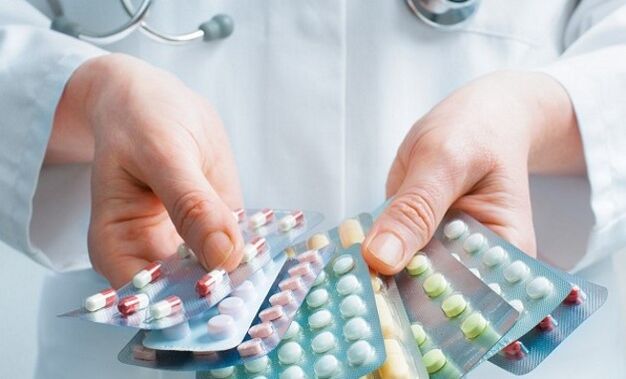
It is important to know. Chondroprotectors are prescribed as a background treatment. They should be taken for a long time, from 3 months to six months. You cannot try to replace the pills prescribed by your doctor with cheaper equivalents. They may not work, and time will be wasted, and the person will develop grade 3 knee osteoarthritis, which is fraught with serious complications, for example, synovitis.
Traditional methods
Patients with knee osteoarthritis are advised to eat woodlice, nettles and celery. The leaves of fresh woodlice can be used to prepare salads, which are seasoned with a small amount of vegetable oil.
Nettle can be added to vegetable soups, or you can make an infusion with garlic and lemon:
- For 100 g of garlic cloves, 3 medium lemons and 250 g of nettle leaves should be taken.
- Pass all the ingredients through a meat grinder.
- Pour the resulting mixture with 3 liters of boiling water and let stand for a day in a warm place.
The infusion should be taken daily. On the first day, limit yourself to 70 ml of the product and gradually increase the number of doses up to 3 times a day.
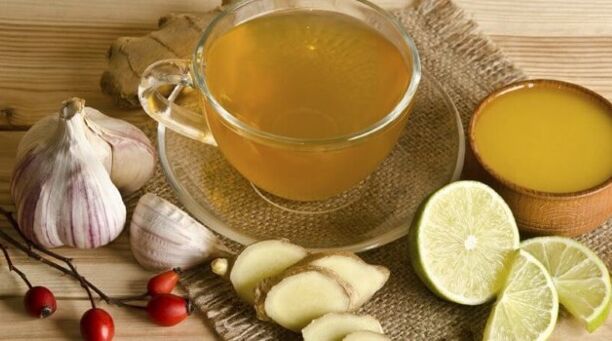
You can make compresses from a decoction of burdock rhizome:
- 3 tablespoonsPour the crushed raw materials with a glass of boiling water.
- Insist for 15 minutes.
- Cool.
- Moisten the gauze in the broth and apply to the affected joint.
- Wrap the sore spot and let sit overnight.
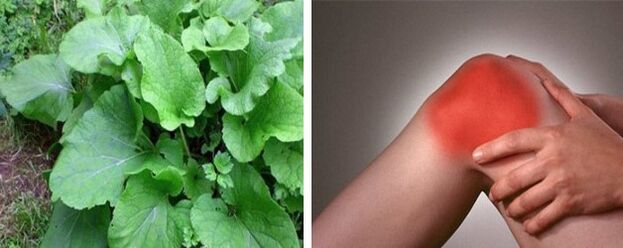
A useful and general tonic for knee osteoarthritis is a broth boiled from cattle bones. The healing effect is provided by gelatin, which is released as a result of prolonged heat treatment.
To prepare the broth, take the beef knees and hooves, place them in a large saucepan and pour water over them so that they completely cover the bones.
Bring to a boil and simmer until the meat and cartilage easily separate from the bones. 100 ml of broth should be taken before meals.

Physiotherapy
If a person is diagnosed with grade 1 or 2 knee osteoarthritis, the doctor may prescribe various physiotherapy procedures:
- Paraffin applications are warming procedures that prevent the development of degenerative processes in the joint joint.
- Plasmolifting, when a drug is injected into the joint cavity from the patient's own blood. Biologically active substances contained in the blood plasma have a healing effect. They cause healing and restoration of affected bone and muscle structures.
- Cryotherapy or local exposure to liquid nitrogen on a sensitive point. The procedure relieves pain and starts regeneration of the damaged joint.
- Laser therapy, which is an effective method that allows you to stop the inflammatory process and stimulate the metabolism in a short time.
- Ultrasound with glucocorticoids, which has an anti-inflammatory and analgesic effect, stops degenerative processes.
- Medicinal electrophoresis with anesthetic is the effect of an electric current on the affected joint, which promotes the penetration of medicinal substances directly into the joint joint.
- Shock wave therapy, which acts on the damaged area with low frequency sound waves, and speeds up blood circulation and metabolism in the diseased joint.
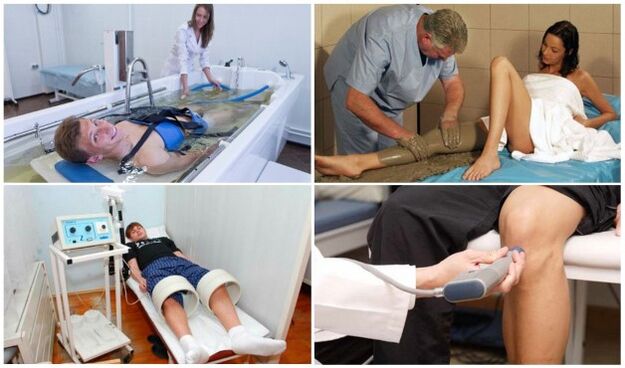
On a note. Physiotherapy procedures can be carried out at home, using a magnetotherapy device, which allows you to relieve swelling and painful sensations, to stop the inflammatory process.
Hirudotherapy
Alternative medicine methods include leech therapy or hirudotherapy.. . .This treatment for knee osteoarthritis has many advantages:
- within 3 months, a persistent analgesic effect is obtained, which allows you to cancel drug therapy;
- metabolic processes are stimulated, blood microcirculation in the affected joint area is improved;
- the pockets disappear;
- mobility of the joint is restored;
- clots are removed, which often form due to the development of knee osteoarthritis.
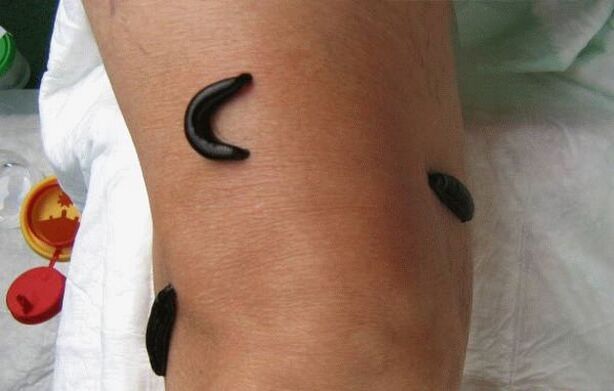
Hirudotherapy works best in the early stages of disease development. The healing effect on the affected area is due to the enzymes that the leeches release into the patient's blood after sucking on the painful knee. These are chemically active substances which:
- dissolve thrombotic compounds, prevent blood clotting;
- lower cholesterol levels;
- break down hyaluronic acid.
On a note. Enzymes such as eglin and kininase can replace nonsteroidal anti-inflammatory drugs and pain relievers.
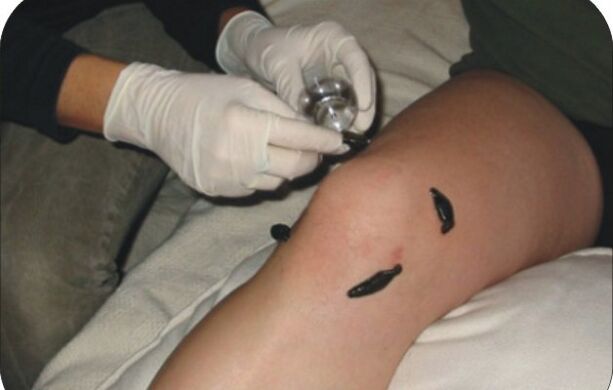
Special exercises
Recreational gymnastics is an effective way to treat a condition that affects the joint joints. The purpose of the exercise is to strengthen the muscles, which will give support to the damaged joint and allow it to regain mobility.
With knee osteoarthritis, strength exercises, walking or prolonged running are contraindicated. Classes should be alternated with rest.
The positive effect will be noticeable if you exercise regularly for at least six months. Approximate set of exercises:
- Swing of the legs with moderate amplitude. It is best performed while sitting on a high chair or table so that your legs hang in the air.
- Without changing position, you can alternately lift your legs, straighten them at the knees, maintain the pose for at least 3 seconds.
- The next exercise is a bicycle. It is performed while lying on the floor. Simulate cycling slowly at first, gradually increasing the pace, then slowing down again.
- From a lying position, you should slowly bend your knee and pull it towards your stomach. Then also gently straighten the bent limb until there is tension in the muscles. It is necessary to hold the pose for 8 seconds. Then lower the heel to the floor and slowly straighten the leg back to its original position.
A set of therapeutic exercises is suitable for the treatment of knee osteoarthritis. A physiotherapist should be consulted before loading.
Massage
This method can not get rid of the disease, but it is able to alleviate symptoms, alleviate periods of exacerbation, and also increase the effectiveness of physiotherapy and drugs.
Massagewith knee osteoarthritis:
- relaxes the spasmodic muscles around the affected joint;
- accelerates the healing process;
- "Evacuates" toxic substances accumulated in tissues as a result of inflammation.
For the treatment of knee osteoarthritis, the following methods are used:
- Japanese, which acts on the affected areas with the help of occasional physical exertion;
- Swedish uses rubbing, stroking a painful joint with the palms;
- Finnish, when all the kneading movements are done with the thumbs.
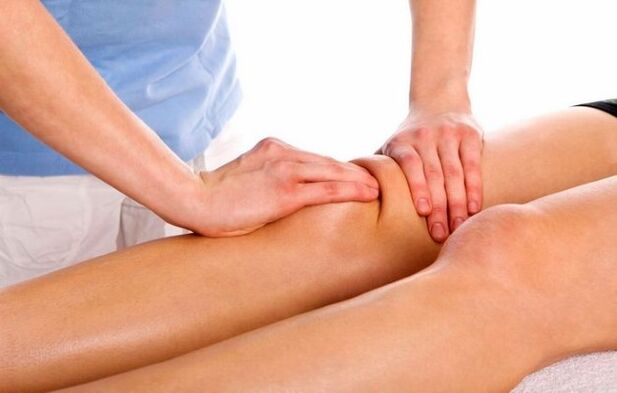
The massage includes not only a mechanical action on the affected limb, but also a massage of the lower spine. During the procedure, the person should not feel pain in the damaged joint.
Self-massage at home is authorized. First of all, you need to study the technique of performing massage movements:
- to stroke;
- friction;
- kneading;
- tapping or showering on the finger;
- vibration.
Ground rules for the procedure:
- Self-massage is done on an empty stomach.
- It is better for a person to take a hot shower or bath at this time (the water temperature should not exceed 36-38 ° C).
- The procedure is carried out in the morning, before 2: 00 p. m. , as it tones the body.
- All movements are carried out carefully, there should be no marks, bruises on the skin, a person should not feel pain during self-massage.
- The procedure begins from the larger femoral muscle, moving from the knee joint to the crease in the groin.
- At the end of the exposure, it is recommended to bend and straighten the leg at the knee several times.
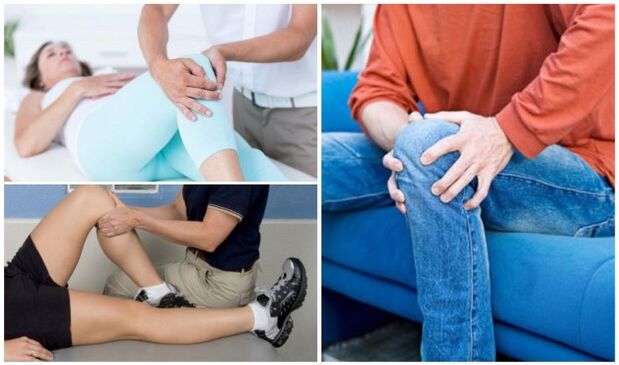
Important. Before resorting to self-massage, you need to consult an orthopedist.
Disease prevention
Various reasons lead to osteoarthritis:
- overweight;
- bad lifestyle;
- excessive physical activity;
- genetic predisposition.
Prevention of knee osteoarthritis includes various measures, for example, dieting, avoiding alcohol and tobacco, physical education, which eliminates increased stress on the knee joints. Health sports activities include:
- Nordic walking, which uses special equipment, such as ski poles;
- yoga, which increases the flexibility of the joints, speeds up the metabolism, has a beneficial effect on the whole body;
- Exercise bike activities that help keep your knee joints healthy.
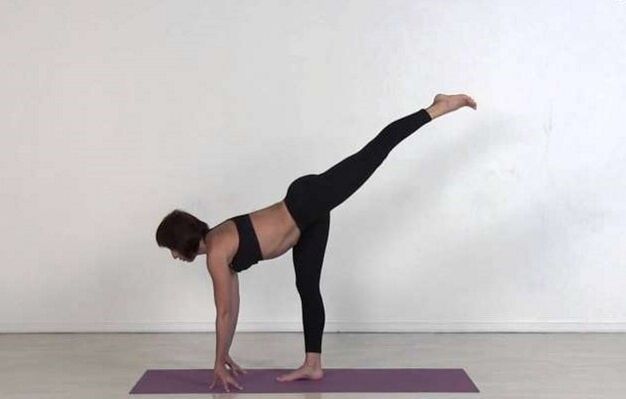
If a person leads an active lifestyle - in-line skating, cycling, skiing, he should take care of protective equipment that will help prevent micro-injuries and significant injuries to the knee. All physical activity should be moderate and sports activities should be alternated with rest.
































